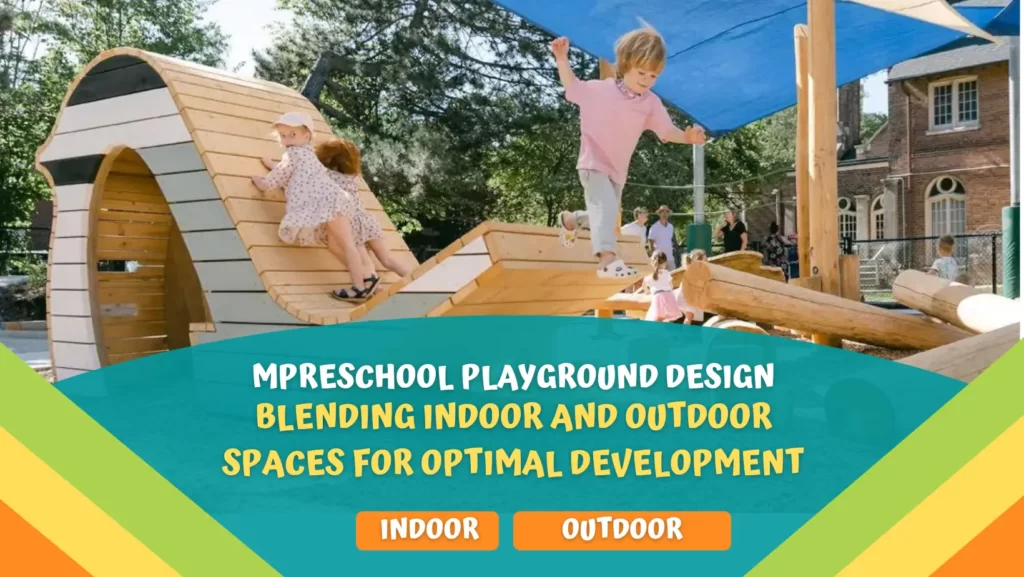As the CEO of Xiha Montessori, I have dedicated my career to understanding and implementing effective preschool playground designs. In this comprehensive exploration, we will delve into how both outdoor and indoor playground designs contribute significantly to early childhood development.
Outdoor playground design is essential for physical development, offering children the opportunity to engage in active play, explore nature, and develop gross motor skills. Indoor playground design, on the other hand, focuses on stimulating cognitive and social skills in a safe, controlled environment. Balancing these two elements is key to creating a holistic developmental experience for preschool children.
The impact of Preschool Playground Design in school education is profound. It’s about crafting spaces that transcend traditional play, creating environments where every element nurtures a child’s future growth.

Comprehensive Insights into Preschool Playground Design: Outdoor Playgrounds
Maximizing Physical Development through Play
In the sphere of preschool playground design, the outdoor environment serves as a critical space for promoting physical development in young children. These playgrounds should be thoughtfully equipped with a range of play equipment that encourages a spectrum of physical activities. Climbing structures, for example, are excellent for building muscle strength and enhancing coordination. Running tracks and open spaces encourage cardiovascular health and endurance. Meanwhile, features like balancing beams and hopscotch grids can improve motor skills and spatial awareness.
The design of these areas should also consider the developmental stages and abilities of different age groups. For younger children, equipment should offer gentle challenges that encourage exploration without overwhelming them. For older preschoolers, more complex structures can provide the necessary challenges to further refine their physical abilities.
Embracing Nature in Outdoor Playground Design
An integral aspect of modern preschool playground design is the integration of natural elements. Outdoor play areas enriched with sand, water features, gardens, and a variety of plant life offer rich sensory experiences that are vital for children’s development. These elements not only stimulate the senses but also foster a deep connection with the environment.
Sand areas, for example, provide tactile experiences and encourage imaginative play. Water features like small streams or splash pads offer opportunities for children to learn basic principles of physics while engaging in sensory play. Planting areas can be used to teach children about biology and the life cycle of plants, promoting environmental awareness and responsibility from an early age.
Prioritizing Safety and Inclusivity
Safety is a foundational element in the design of outdoor playgrounds for preschools. This encompasses not just the selection of safe, non-toxic materials but also the careful design of play equipment and the overall layout of the playground. It is essential to ensure that equipment is age-appropriate and installed with proper fall protection, like mulch or rubber matting.
Inclusivity is another vital component of playground design. Play areas should be accessible to children of all abilities, including those with physical or developmental challenges. This can be achieved through features like wheelchair-accessible paths, sensory play elements designed for children with sensory processing disorders, and play structures that are safe and engaging for children of various abilities.



Rethinking Preschool Playground Design: Advancing Indoor Play Areas
Fostering Imagination and Cooperation in Unique Settings
The innovation in indoor playground design for preschools lies in creating unique environments that inspire imagination and promote cooperation among children. Moving beyond traditional play structures, these spaces can feature interactive and thematic elements like miniature towns, space explorations, or fairy-tale forests. Such environments not only spur imaginative play but also encourage children to work together, solve problems, and engage in role-playing scenarios that are essential for social and emotional development.
Customizing Safe and Engaging Play Experiences
In crafting indoor playgrounds, customizing play experiences to suit diverse needs and preferences is key. This involves designing areas that vary in stimulus intensity – from vibrant, energetic zones to quiet, contemplative spaces. For instance, a bustling marketplace setup can encourage dynamic social interaction, while a cozy reading nook offers a calm retreat. This diversity ensures that all children, regardless of their sensory sensitivities or social preferences, find a space that resonates with them.
Integrating Technology and Interactive Learning
A forward-looking aspect of modern preschool playground design is the integration of technology and interactive learning elements. This could include touch-screen panels for interactive learning games, augmented reality experiences that bring stories to life, or light and sound installations that respond to children’s movements. These high-tech features not only make learning more engaging but also help develop digital literacy from an early age.



Space Adaptability and Multi-Functional Use
Innovative indoor playground design also focuses on the adaptability of space. Utilizing modular and multi-functional play equipment allows for the transformation of play areas to suit different activities and learning objectives. For example, modular units could be rearranged to create a physical obstacle course one day and a collaborative building project the next. This adaptability not only maximizes the utility of the space but also provides an ever-changing environment that keeps children engaged and excited about new challenges.
Emphasizing Interactive and Sensory Play
A critical element in indoor playgrounds is the emphasis on sensory and interactive play. This can be achieved through installations like sensory walls with varied textures, sound tubes, and visual puzzles. Such features cater to the developmental needs of children by enhancing tactile, auditory, and visual processing skills, crucial for overall sensory development.
Synergizing Indoor and Outdoor Playground Designs
Complementary Designs for Holistic Development
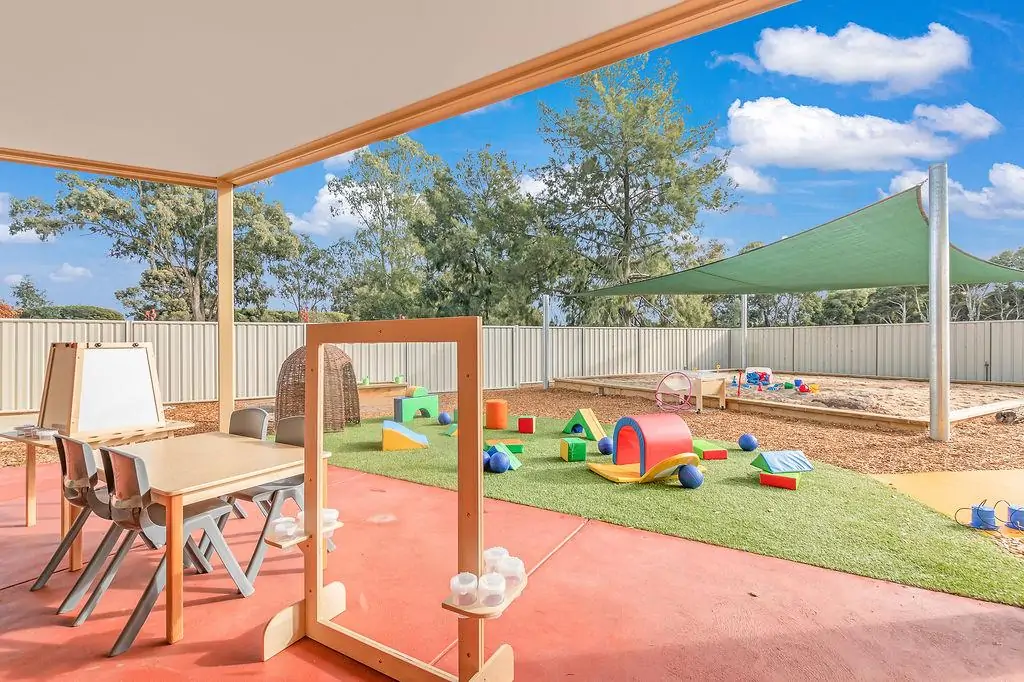
A well-planned Preschool Playground Design should seamlessly integrate both indoor and outdoor playground designs, ensuring a balanced approach to physical, cognitive, and social development. While outdoor spaces provide opportunities for vigorous physical activities and connection with nature, indoor spaces offer a controlled environment for creative, sensory, and educational play.
Transitioning Spaces
Preschool Playground Designing can transitional areas that smoothly link indoor and outdoor spaces can enhance the play experience. These areas can serve as buffer zones, offering a variety of semi-outdoor activities and helping children adjust between the two different environments.

Insights on Preschool Playground Design: Elements of Outdoor Playgrounds
Comprehensive Range of Play Equipment
In the realm of preschool playground design, the diversity of play equipment is fundamental. A well-equipped outdoor playground should cater to various developmental stages and interests of young children. This includes a wide array of play structures such as swings for developing balance, slides for spatial awareness, climbing frames for enhancing motor skills, and sand areas for sensory play. Each piece of equipment plays a pivotal role in promoting different aspects of physical and cognitive development.
For instance, swings not only provide physical benefits like improving core strength and coordination but also offer sensory stimulation. Slides introduce concepts of gravity and spatial orientation, while climbing frames challenge children to develop problem-solving skills and physical agility. Sand areas are excellent for sensory development, offering endless opportunities for creative play and fine motor skill enhancement.
Integrating Learning with Outdoor Play
Innovative preschool playground design goes beyond physical play, incorporating elements that make learning an integral part of the outdoor experience. Educational features such as gardens, weather stations, and simple science experiments can transform a playground into a living classroom.
Gardens in playgrounds allow children to learn about plant life cycles, understand the basics of botany, and develop a sense of responsibility through caring for living things. Weather stations can pique children’s curiosity about meteorology, teaching them about different weather patterns and the environment. Simple, hands-on science experiments, like water tables or basic physics playsets, can ignite an interest in scientific exploration and observation, fostering a sense of wonder about the natural world.
These learning experiences are invaluable as they provide practical, real-world applications of classroom concepts in a playful and engaging outdoor setting. This approach to integrating play with learning supports a holistic educational philosophy, where children learn through doing and exploring.
Emphasizing Sustainability and Durability in Materials
The choice of materials in preschool playground design is a reflection of both environmental stewardship and a commitment to safety and longevity. Using sustainable and eco-friendly materials in playground construction is not just an environmentally responsible practice but also an educational opportunity. It demonstrates to children the importance of preserving the natural world.
Selecting durable materials for playground equipment is equally important. Durability ensures the longevity of the playground, reducing the need for frequent replacements and repairs. This not only makes economic sense but also ensures continuous safety for children. Materials such as recycled plastic, sustainably sourced wood, and metal with protective coatings are popular choices. These materials are not only robust and long-lasting but also reduce the playground’s ecological footprint.
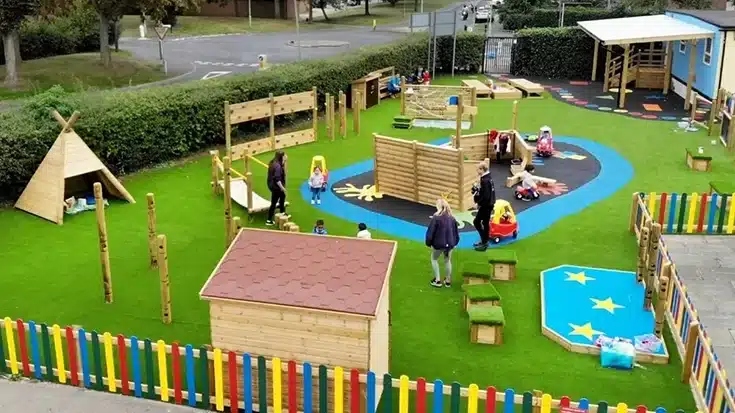
Perspective on Preschool Playground Design: Key Elements of Indoor Playgrounds
Creating Safe and Engaging Indoor Environments
The design of indoor playgrounds in preschool settings is a crucial aspect of fostering a safe and stimulating environment for young children. These indoor areas should be meticulously designed to spark imagination and encourage social interaction in a secure setting. Essential components include soft flooring to cushion falls, padded equipment to prevent injuries, and a selection of age-appropriate toys that promote learning and development. The careful arrangement of these elements is critical to create a safe yet challenging indoor play area where children can explore and learn without risk.
Moreover, the layout of the indoor playground should be thoughtfully planned to encourage a flow of activities, from active play to quieter, more contemplative spaces. This design approach ensures that children can engage in a variety of play styles, catering to different moods and energy levels throughout the day.
Integrating Sensory and Interactive Features
A key element in modern preschool playground design is the inclusion of sensory and interactive features. Indoor playgrounds, especially, can be richly equipped with elements like light and sound play panels, tactile boards, and imaginative play zones. These features are instrumental in supporting sensory development, fine motor skills, and cognitive learning.
Light and sound panels, for instance, provide an interactive experience that can stimulate visual and auditory senses, while tactile boards with different textures encourage sensory exploration and discovery. Imaginative play zones, such as miniature kitchens, tool benches, or fantasy castles, allow children to role-play, fostering creativity, problem-solving skills, and social interaction.
Space-Efficient Design Solutions
In urban environments or locations where space is limited, indoor playgrounds must offer innovative, space-efficient solutions. This aspect of preschool playground design involves the use of multi-level play structures, modular components, and collapsible equipment to effectively utilize the available space.
Multi-level play structures are particularly beneficial as they provide a vertical play experience, expanding the play area without increasing the footprint. Modular designs offer the flexibility to change or expand the playground layout over time, adapting to the evolving needs of the preschool. Collapsible equipment can be stored away when not in use, allowing for the multipurpose use of the space for different activities and events.
These space-efficient designs ensure that even in limited areas, children have access to a diverse range of play options, from physical activities to imaginative and sensory experiences.
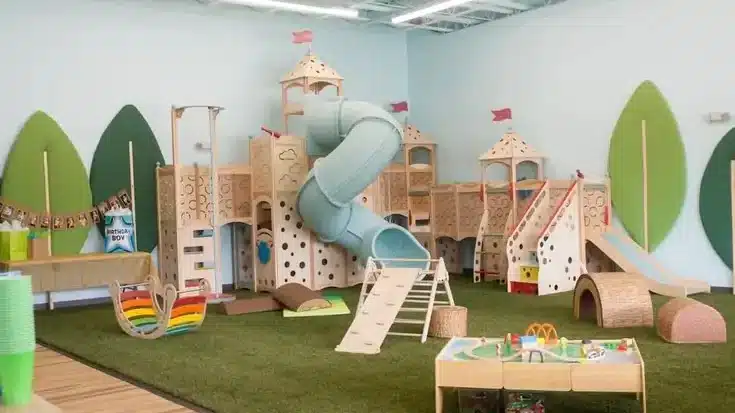
Inclusive Preschool Playground Design for All Abilities
Principles of Inclusive Play Spaces
Inclusive playgrounds are designed to be welcoming and accessible to children of all abilities, including those with physical, sensory, or cognitive disabilities. This involves creating play areas that are barrier-free, with equipment that is adaptable and accommodating for various needs.
Preschool Playground DesignUniversal Design in Playgrounds
A universal design approach ensures that playgrounds are not only accessible but also engaging for all children. This can include wheelchair-accessible paths, sensory-rich play elements, and play equipment that encourages interaction among children with diverse abilities.。
Benefits of Inclusive Play
Inclusive preschool playground design provide significant benefits. They foster empathy and understanding among typically developing children and offer an equitable play experience for children with disabilities. This inclusive approach enriches the social fabric of the preschool environment.


The Impact of Preshcool Playground Design on Childhood Development
Enhancing Physical Health
Playgrounds, both indoor and outdoor, are critical for promoting physical health. They encourage active play, which is essential for physical development, coordination, and overall fitness in young children.
Cognitive and Emotional Growth
Playground design also significantly impacts cognitive and emotional growth. Thoughtfully designed play areas stimulate problem-solving, creativity, and imagination. They also provide spaces where children can experience and manage a range of emotions in a safe setting.
Social Skills and Interaction
Playgrounds are vital arenas for developing social skills. They offer children opportunities to engage in cooperative play, learn conflict resolution, and build friendships, which are crucial for their social and emotional development.

Future Trends in Preschool Playground Design
Integration of Technology
Emerging trends in preschool playground design include the integration of technology. Interactive digital installations, augmented reality play experiences, and educational gaming elements are becoming more prevalent, offering new ways to engage and educate children in a playground setting.
Nature-Inspired Designs
There is a growing emphasis on nature-inspired playgrounds, which blend natural elements like plants, water, and rocks with traditional play equipment. This approach encourages children to connect with nature and learn about the environment in an interactive way.
Sustainable and Eco-Friendly Playgrounds
Sustainability is becoming a key consideration in preshcool playground design. Using recycled materials, implementing energy-efficient solutions, and designing with a minimal environmental footprint are practices that are gaining importance in creating eco-friendly play areas.
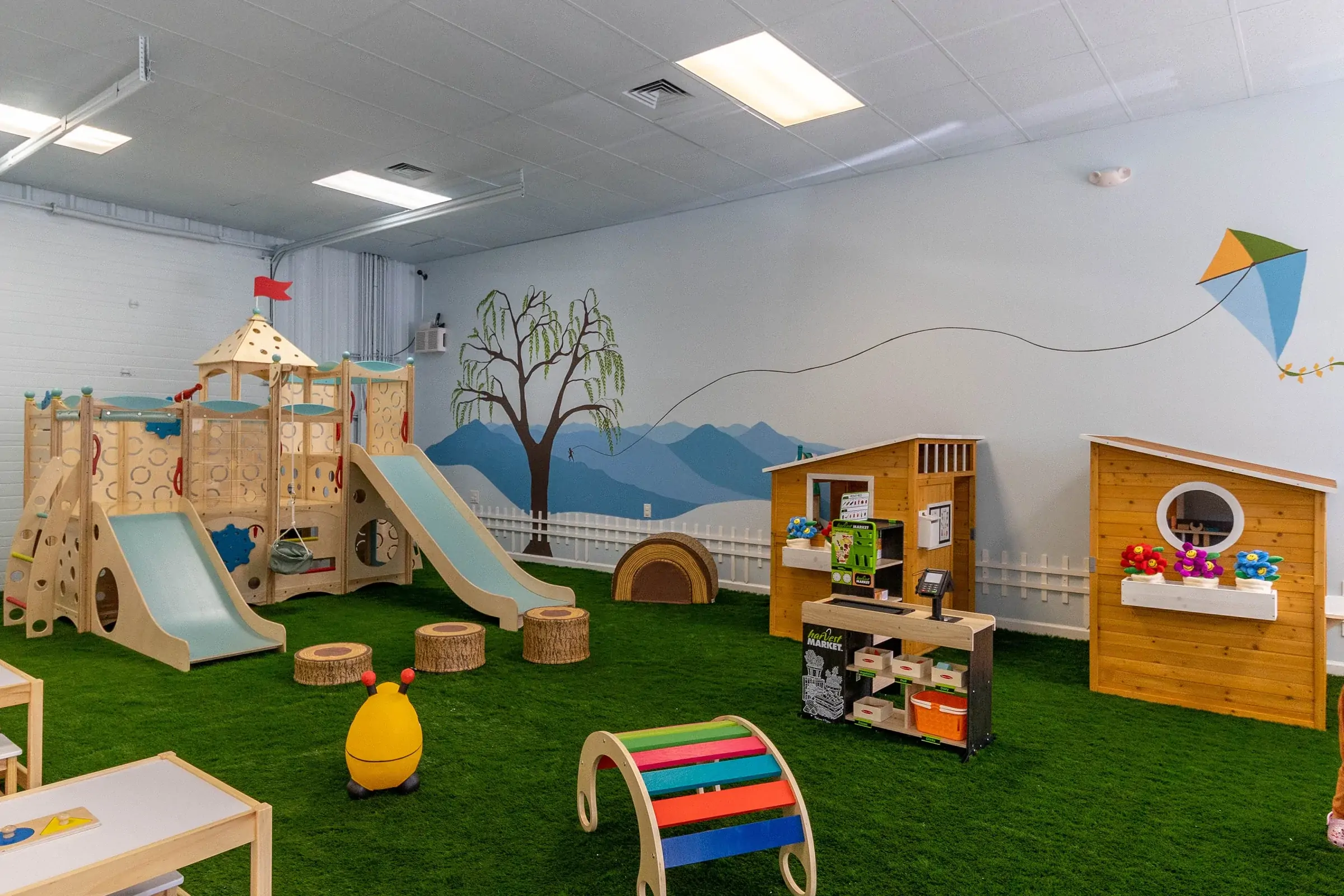

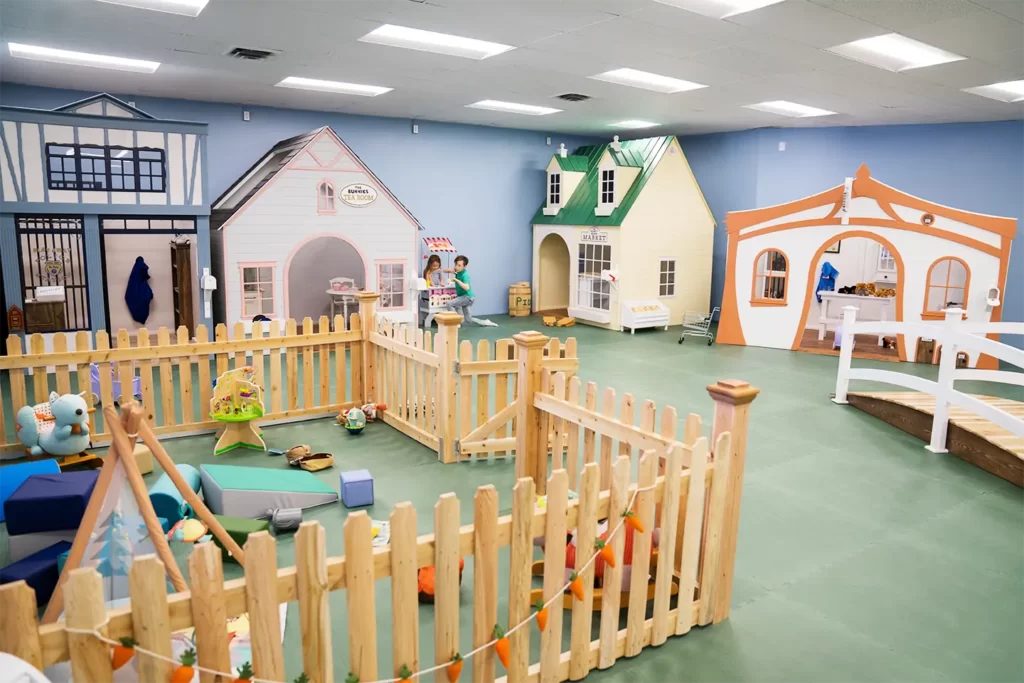
The field of preschool playground design is dynamic and ever-evolving, reflecting the changing understanding of children’s needs. Both indoor and outdoor playgrounds play pivotal roles in fostering physical, cognitive, and social development in young children. As we continue to innovate and embrace new trends, the potential of playgrounds to shape positive childhood experiences is immense. Emphasizing inclusivity, sustainability, and the integration of technology, the future of preschool playground design holds exciting possibilities for enriching the lives of our youngest learners.
As we reach the end of our exploration into preschool playground design, it’s evident that these spaces are much more than areas for mere play. They are integral to the developmental tapestry of early childhood, weaving together threads of physical, cognitive, and social growth.
The journey through the complexities of outdoor and indoor playground design has highlighted how each space serves distinct, yet complementary roles. Outdoor playgrounds, with their emphasis on physical activity and interaction with nature, provide an arena for children to develop gross motor skills, discover the environment, and engage in vigorous play. These spaces are essential for nurturing children’s physical health, offering them the freedom to explore, take risks, and embrace the natural world.
Indoor playgrounds, in contrast, offer a sanctuary for cognitive and social development. Here, in these thoughtfully designed environments, children engage in imaginative play, refine their fine motor skills, and navigate the complexities of social interactions. These areas are crucial for fostering creativity, problem-solving skills, and emotional intelligence, providing a safe and controlled setting for exploration and learning.
The balance between these two playground types is not just a matter of physical space allocation, but a harmonious blend of learning opportunities. A well-designed preschool playground acknowledges and caters to the multifaceted needs of growing children, aiming to stimulate every aspect of their development.
Looking ahead, the future of preschool playground design holds immense potential. As we embrace new technologies, innovative materials, and a deeper understanding of child development, these playgrounds will continue to evolve. They will not only reflect the changing needs of our society but also anticipate the future demands of early childhood education.
In conclusion, the art of preschool playground design is a testament to the value we place on nurturing our youngest generation. It’s a commitment to providing them with the best start in life, offering spaces that challenge, inspire, and support their growth into well-rounded individuals. As educators, designers, and caregivers, our role in shaping these environments is both a privilege and a responsibility. Let’s continue to create playgrounds that are not just places to play, but spaces to grow, learn, and dream.

